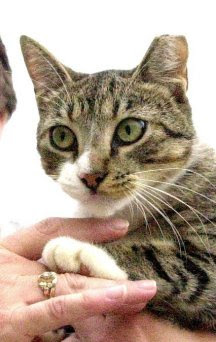Probably a few feral cats live in your neighborhood. You may even have a sizable colony in your area and not know about it. If an outside cat does not appear to be friendly, there's a good chance that it is a feral - not a stray. A stray is a pet that has become lost, while a feral cat has never been a pet and is not friendly towards people (to put it mildly). These are cats that have little to no experience with humans. They are elusive, fearful, and do not trust people.
 |
| Feral cat on ECU campus, via Saving Graces |
 |
| Feeding operations quickly attract large numbers of ferals and strays |
 |
| Unless the cycle is stopped, this feral mama will continue to have multiple litters a year - and so will each of her female offspring. |
With TNR, the cats are allowed to live, but they are not allowed to produce more feral cats. The colonies stabilize in number, and without the added drama of breeding, males fight less, and females are much healthier. With a steady source of food, the cats hunt less, and the colony overall is much safer, happier, and more palatable to the humans that live around them.
 |
| Greenville feral with tipped ear, via Saving Graces |
Ferals are either the offspring of other feral cats, or of lost or abandoned pets. In order for a cat to be comfortable with people, they must be properly socialized during a critical phase of their young lives. Kittens under 8 weeks are relatively easy to socialize, while kittens of 8 weeks to 6 months take much more time and energy. Cats that reach six months without human contact will be extremely fearful of humans and usually too wild to socialize.
This is why HSEC does not accept feral cats. There are many well-socialized pets that need our help, and feral cats are not adoptable. They really would rather not live in your home. The shelter environment is even more stressful for ferals than for strays, and it is difficult for the staff to feed, medicate, and handle these wild animals.
There are organizations which provide help and care either specifically to ferals, or to ferals and stray cats. In Greenville, Saving Graces 4 Felines provides support for colony feeders who practice TNR. HSEC has also transported a small number of cats to Pigs, a sanctuary in West Virginia that specializes in rescuing pot-bellied pigs, and additionally serves as a home of last resort for less adoptable dogs, cats, and other farm animals.
 |
| Ghost, an HSEC alum now at Pigs Sanctuary |
For more information, take a look at Saving Grace's feral information website and the Humane Society of America's feral cats FAQ, both of which have a lot of great details.
It may be strange to see a cat as a wild animal, but with the right management and support, these creatures can be just another part of the landscape.
Edited to add: the HSEC blog reserves the right to remove abusive comments. Opposing opinions are welcome provided they are composed in a respectful and appropriate manner.


Great and informative post. Thanks! TNR definitely works.
ReplyDelete